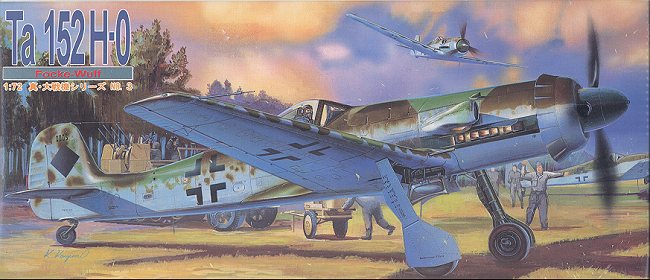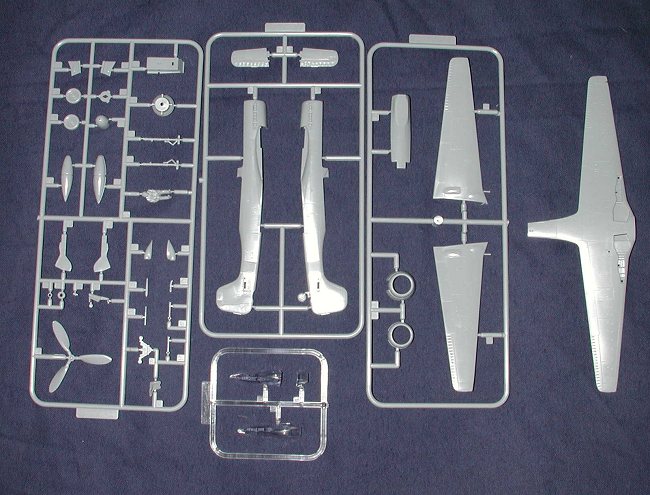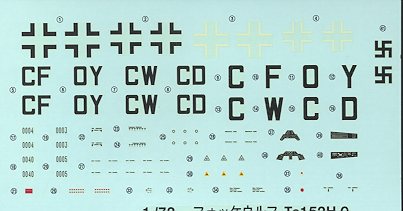
|
KIT: |
Aoshima 1/72 Ta-152H-0 |
|
KIT # |
16503 |
|
PRICE: |
$24.00 |
|
DECALS: |
See preview |
|
REVIEW & |
|
|
NOTES: |

|
HISTORY |
The first two paragraphs are basically a repeat of what was stated with the DML Ta-152H-1 preview.
If nothing else, Kurt Tank, the main designer at Focke-Wulf, was a man who anticipated things. While production of the Fw-190 was underway, he was also working on a high altitude version of the aircraft. At this same time, the RLM was looking for a way to intercept the high altitude bombers that the Allies were sure to develop. Current fighters just were not capable of performing that task. The RLM put for the proposal during 1942, asking both Messerschmitt and Focke-Wulf to come up with designs. Messerschmitt offered the Me-155, and Tank offered something based on the current Fw-190.
Well, as luck would have it, Messerschmitt had nothing but problems with the -155 and had to turn over development to Blohm und Voss, as other projects kept him from working on it. Tank, on the other hand, was able to produce functioning prototypes using the Jumo 213 engine by late 1944. In fact, Tank envisioned a whole series of aircraft, including a low level fighter, a fighter-bomber and high altitude interceptor. The Ta-152C (the aircraft was given the Ta designation vice Fw in honor of Kurt Tank who designed it), was built in very small numbers, the fighter-bomber wasn't built at all, so most 152s were the high altitude version.
The Ta-152 H-0s were all initial production aircraft and prototypes that were developed from Fw-190A-8 airframes. They were virtually identical to the later Ta-152H-1. There is no external way to tell them apart other than serial numbers. The H-1 had extra fuel tanks in the wings which were not installed in the H-0. Ta-152H-0s were all assigned to one unit, JG 301, or kept as test aircraft. Those test aircraft were informally organized into Jagdstaffel Ta152. Their lack of range was not a problem by the time the unit was up to speed on the plane as lack of fuel prevented any long range flights. Often they were flown with only on-board fuel and didn't have the drop tank attached. It had superb speed and the ability to out run and out maneuver almost everything in the sky. It is a shame for the Germans that it came along so late as it was easily the best piston-engined fighter that the Luftwaffe had.
|
THE KIT |

Where the Dragon kit is a mass of small parts and complicated construction, the Aoshima kit is nearly the opposite. Detail is quite good, but not up to the Dragon kit. For instance, the instrument panel has instruments supplied as a decal. The nose is complete instead of separate, and the forward section of the wheel wells are closed as there is no engine detail to be seen, unlike the Dragon kit which basically gives you a complete engine.
What Aoshima does give you are two different noses with cowl flaps open or closed as well as two canopies, one for a closed canopy version and one open. Just by a quick comparison between the two, I'd say that the Aoshima kit has half the number of parts of the Dragon kit. Therefore, it should be an easier build. Interestingly, the Aoshima kit is the more expensive of the two here in the US.

|
REFERENCES |
Mongram Closeup #24: Ta-152 by Jeff Ethell, 1990
Focke-Wulf Ta-152 by Dietmar Harmann, 1999
Review kit courtesy of me and my wallet!
If you would like your product reviewed fairly and quickly by a site that has over 1,500 visits a day, please contact me or see other details in the Note to Contributors.